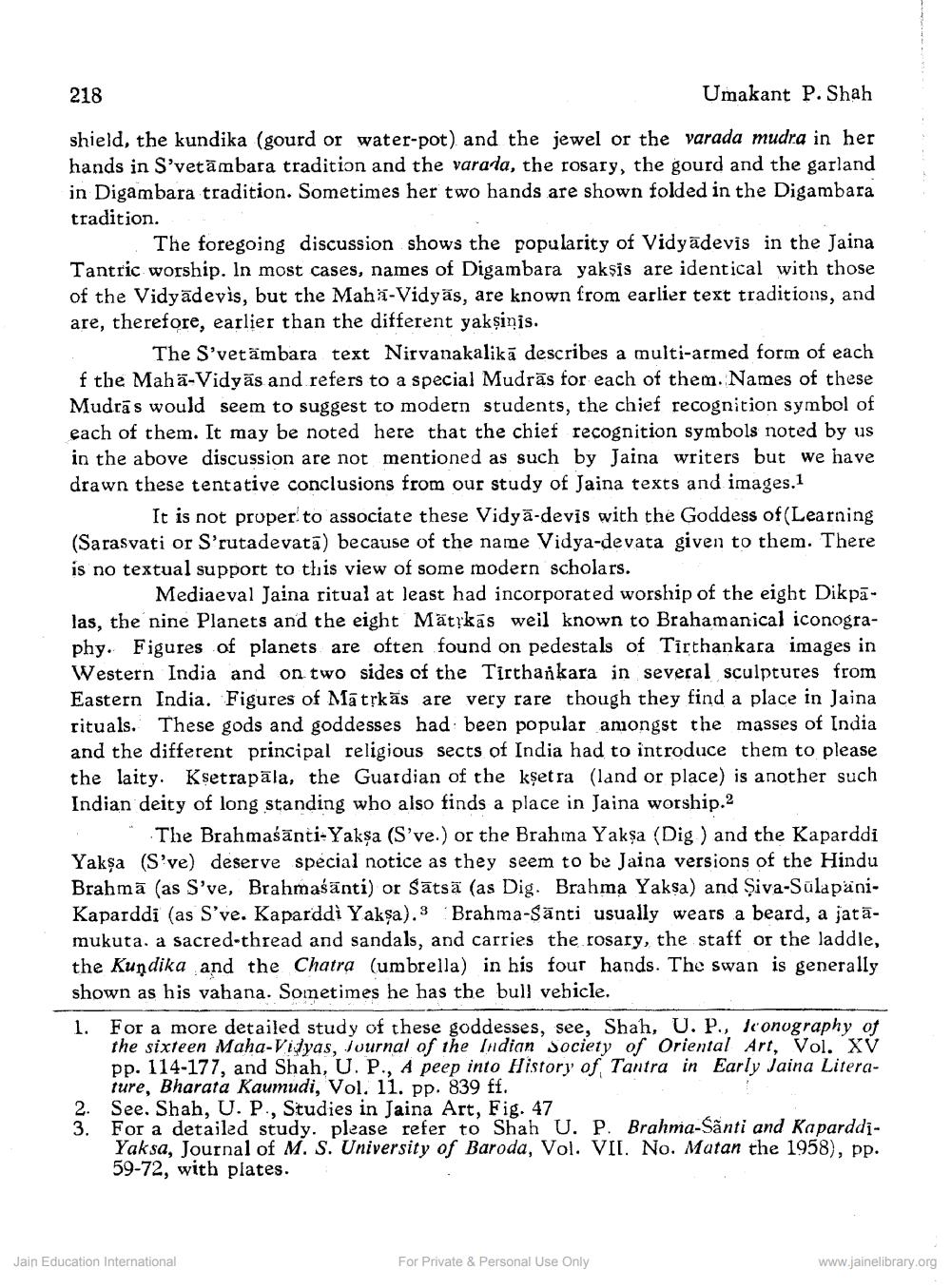________________
218
Umakant P. Shah
shield, the kundika (gourd or water-pot) and the jewel or the varada mudra in her hands in S'vetāmbara tradition and the varadda, the rosary, the gourd and the garland in Digambara tradition. Sometimes her two hands are shown folded in the Digambara tradition.
The foregoing discussion shows the popularity of Vidyādevis in the Jaina Tantric worship. In most cases, names of Digambara yakṣis are identical with those of the Vidyadevis, but the Mahä-Vidyās, are known from earlier text traditions, and are, therefore, earlier than the different yakșinis.
The S'vetämbara text Nirvanakalikā describes a multi-armed form of each f the Maha-Vidyās and refers to a special Mudrās for each of them. Names of these Mudrās would seem to suggest to modern students, the chief recognition symbol of each of them. It may be noted here that the chief recognition symbols noted by us in the above discussion are not mentioned as such by Jaina writers but we have drawn these tentative conclusions from our study of Jaina texts and images.1
It is not proper to associate these Vidyā-devis with the Goddess of(Learning (Sarasvati or S'rutadevata) because of the name Vidya-devata given to them. There is no textual support to this view of some modern scholars.
Mediaeval Jaina ritual at least had incorporated worship of the eight Dikpālas, the nine Planets and the eight Mätykás weil known to Brahamanical iconography. Figures of planets are often found on pedestals of Tirthankara images in Western India and on two sides of the Tirthankara in several sculptures from Eastern India. Figures of Mātřkās are very rare though they find a place in Jaina rituals. These gods and goddesses had been popular amongst the masses of India and the different principal religious sects of India had to introduce them to please the laity. Ksetrapāla, the Guardian of the kşetra (land or place) is another such Indian deity of long standing who also finds a place in Jaina worship.2
"The Brahmaśānti-Yaksa (S've.) or the Brahma Yakşa (Dig ) and the Kaparddi Yakşa (S've) deserve special notice as they seem to be Jaina versions of the Hindu Brahmā (as S've, Brahmaśānti) or $ātsā (as Dig. Brahma Yaksa) and Şiva-Sūla päniKaparddi (as S've. Kaparddi Yakşa).3 Brahma-Sānti usually wears a beard, a jatāmukuta. a sacred-thread and sandals, and carries the rosary, the staff or the laddle, the Kundika and the Chatra (umbrella) in his four hands. The swan is generally shown as his vahana. Sometimes he has the bull vehicle. 1. For a more detailed study of these goddesses, see, Shah, U. P., kronography of
the sixteen Maha Vidyas, Journal of the Indian Society of Oriental Art, Vol. XV pp. 114-177, and Shah, U. P., A peep into History of Tantra in Early Jaina Literature, Bharata Kaumudi, Vol. 11. pp. 839 ff. See. Shah, U.P., Studies in Jaina Art, Fig. 47 For a detailed study. please refer to Shah U. P. Brahma-Santi and KaparddiYaksa, Journal of M. S. University of Baroda, Vol. VII. No. Matan the 1958), pp. 59-72, with plates.
3:
Jain Education International
For Private & Personal Use Only
www.jainelibrary.org




